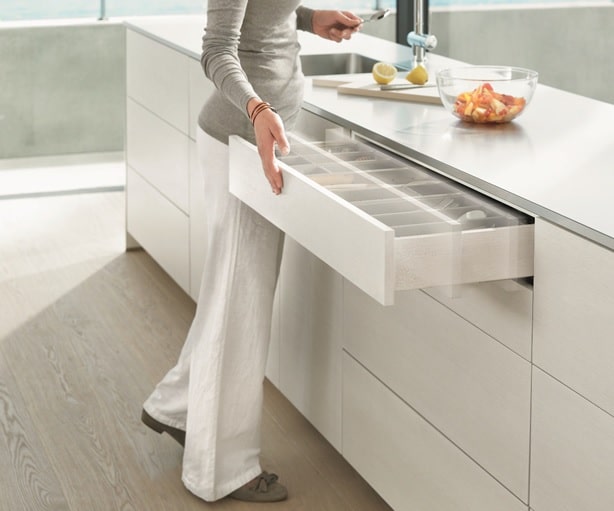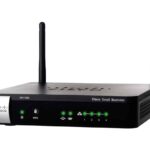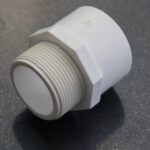Do your soft-close drawers make it hard for you to open them? Nobody enjoys having to open and close their drawer with force every time they want to get something from inside.
Unfortunately, many soft close mechanisms seem to be quite faulty and can take quite a bit of effort to manoeuvre open. Many people struggle with this problem, so here are some solutions for the issue:
Soft Close Drawers Hard to Open
Table of Contents
Check the Drawer Tracks and Guides
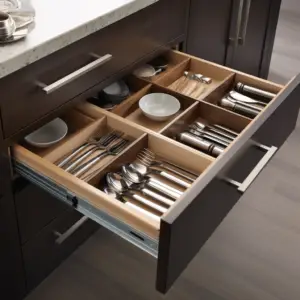
Check the drawer tracks and guides. The tracks are usually located in the front of the cabinet and are made of plastic or wood. When they become worn or damaged, they can cause drawers to stick. The guides are metal rods that fit into grooves on either side of the track; they help guide the drawer as it opens and closes.
If you find that one or more drawers are hard to open, check for this common problem:
- The guides are bent or broken. If you see a gap between the bottom of your cabinet and the floor, one or more of your drawer guides will likely break off.
To fix this problem, use a hammer to tap back in place gently. You may need to use pliers to remove any remaining screws from your old guide before replacing them with a new one.
Replace Worn-out Drawer Slides
If your drawers are hard to open, it may be time to replace the drawer slides. The good news is that it’s an easy DIY project that can make a huge difference in how smoothly your drawers open and close.
Replacing worn-out drawer slides is a snap, and you only need a few simple tools and some basic skills.
Here’s how to do it:
If your drawers are mounted on metal runners, you’ll need to remove them from their tracks before taking them apart. To do so, grab an adjustable wrench or pipe wrench; a standard adjustable wrench won’t cut it. Loosen the screw at either runner’s end by turning counterclockwise until it comes off completely.
You may need to break the head off with pliers. Lift out one end of each metal runner at a time until they’re free from the cabinet bottom. Set aside all hardware that goes along with the runners, so you don’t lose any parts in the process and leave enough room behind your cabinets for easier access later.
Fix Slipped Screws or Nails
Slipped screws or nails are a common cause of drawers that stick. The fix is simple and only takes a few minutes.
First, remove the drawer from its track by removing the screws holding it in place. Then check to see if any screws have become loose. Tighten them and replace the drawer, sliding it back into place.
If your drawer has metal tracks instead of wooden ones, you may need to replace the tracks instead. This is also an easy do-it-yourself project that requires just a few tools and supplies.
To remove a metal track from a cabinet or drawer, use pliers to grip each end of the track and gently bend it back and forth until it comes off of its connector bolts at both ends. If there’s no way to bend the track back far enough to clear the bolts, you’ll have to remove those first before bending out enough of the track so you can get at them with pliers or vice grips.
Check other Types of Hardware
If you still have difficulty opening your drawers, it could be because your hardware is too heavy. The weight of the hardware pulls on the drawer and makes it hard to open.
By switching to lighter-weight hardware, you can reduce the force required to open your drawers. There are several types of hardware that you can try:
Stainless steel ball-bearing rollers are designed for use with soft-close drawers. These rollers allow the drawer to glide easily when opened, but they also create more resistance when closed so that they close slowly and softly.
You can try a nylon roller if you have wood or melamine drawers. This type of roller is made from nylon and has a low coefficient of friction that allows the drawer to slide easily when opened, but it also creates more resistance when closed so that they close slowly and softly.
Another option is an aluminum handle with a magnetic closure system. This type of handle is made from aluminum with a magnet embedded inside it that helps hold it in place when not in use. The magnet also helps prevent the cabinet door from slamming shut accidentally when you’re trying to open it.
Adjust or Replace Hinges
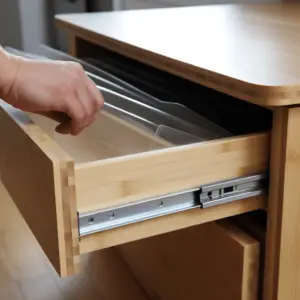
If the drawers are hard to open, it’s likely the hinges are misaligned or worn. You can try adjusting the hinges, or if they’re badly worn, you’ll need to replace them.
Adjusting cabinet hinges
- Remove all hardware from the drawer and remove the drawer.
- Use a putty knife to scrape off any paint that may be on the screw heads.
- Loosen each hinge screw by turning it counterclockwise using a head screwdriver. If you don’t have a head screwdriver, you can use a flathead or a hex six-sided head screwdriver instead. Just be sure not to strip out any screws when removing them from the holes in your cabinet door or drawer front panel.
- With your fingers, gently lift up on each corner of your door or drawer front panel until it’s level with its neighbour along its full length and across its width. Lower the door onto its hinges and then secure each hinge back into place by tightening each screw with your head screwdriver until snug but not overly tight.
Final Word
Now that you know how to prevent a soft-close drawer from sticking, making sure your drawers are properly aligned before installing the drawer is just as important. If you can get the alignment right on the first attempt, you’ll have more success with your soft close drawer in the long run. These top tips should increase your chances of getting it right and avoiding future problems.
